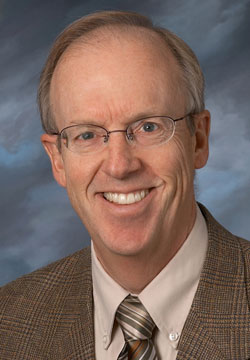The groundbreaking health care reform partnership between the UNMC College of Pharmacy, Walgreens, the Kearney Clinic, P.C., Blue Cross and Blue Shield of Nebraska and the Nebraska Health Information Initiative is rolling out a new model in the treatment of patients with hypertension and type-2 diabetes, as noted last week.
It involves a partnership not just between all of these entities, but between community pharmacists and physicians, too.
 |
Kenton Shaffer, M.D. |
So, how, exactly, did that happen?
Ally Dering-Anderson, Pharm.D., said Dr. Klepser, an assistant professor of pharmacy practice, was a facilitator.
But the project was also able to come together because UNMC has relationships and alumni across the state.
Dr. Dering-Anderson, a clinical assistant professor in the Department of Pharmacy Practice, used to be a full-time Walgreens employee. She stills covers community pharmacy shifts there now and then. So she understood Walgreens’ system and capabilities.
(The third investigator from the College of Pharmacy, Julie Oestreich, Ph.D., assistant professor of pharmacy practice, is an exceptional talent at research, her collaborators said. “She’s awesome,” Dr. Dering-Anderson said.)
And at almost every step, UNMC’s network continued to pave the way.
“It’s one of those fabulous people situations,” Dr. Dering-Anderson said. “The regional manager of Walgreens for that (Kearney) store is Jeffrey Hines, Pharm.D., and he’s one of our alums and a huge supporter of the alumni association, and a big supporter of pharmacy doing more to help the patients.”
The clinic? Kenton Shaffer, M.D., the lead physician at Kearney Clinic’s patient-centered medical home, is a UNMC alum. He and Michael Sitorius, M.D., chairman and Waldbaum Professor of Family Practice in the College of Medicine, go way back.
You know, “If he thinks it’s OK …”
Jannette Arram, Pharm.D., the Kearney Walgreens store pharmacy manager, is another UNMC alum – “A super patient-minded pharmacist,” Dr. Dering-Anderson said.
UNMC’s network and relationships helped everyone feel good about taking a big leap.
“Part of what made this happen is the timing,” Dr. Klepser said. “Five years ago there would have been a lot of reluctance. Maybe in five years there will be a lot more reluctance again. But right now, things aligned. We happened to have a pretty good idea and a pretty good team.”